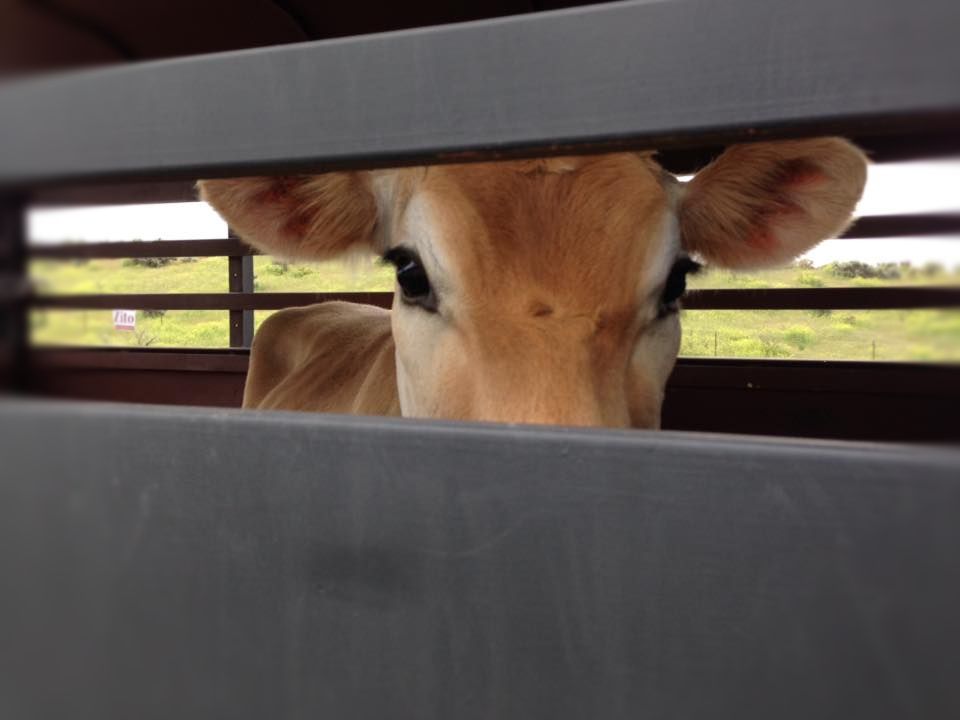
I’m often asked, “Should I buy a proven cow in milk and bred back or a young heifer calf?” In my experience, there isn’t a correct answer to this question. So, let’s explore the pros and cons based on my experience and help you decide what’s right for your situation.
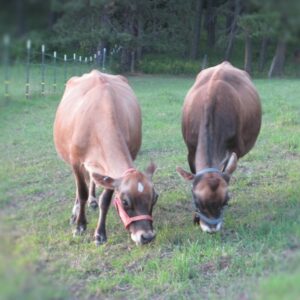
“Should I buy a proven cow or a young heifer calf?”
Should I buy a proven cow?
In many social media groups the advice you’ll receive is to start with an experienced cow, trained to milk, and confirmed pregnant. I agree that there are a lot of good reasons for this advice. However, there are drawbacks and it may not be ideal for everyone to start with a proven cow.
Pros for Buying a Proven Cow:
- Cow is proven fertile
- Could already be trained to milk
- You’ll have milk sooner
- Could already be pregnant
- Experienced in calving
- Udder conformation can be seen
- Mature height is known
Cons for Buying a Proven Cow:
- An older animal has more possible disease exposure
- May have an unknown history
- Bad parlor habits
- Could have udder scar tissue
- Could have a history of abuse
- Harder to halter break
- Need a trailer to transport
- More expensive than a calf
- May be harder to earn her trust
The pros all sound great, but there are lots of possible issues too. We’ve all heard stories of someone who bought a heifer who would never settle (get pregnant), only to learn she’s a Freemartin (sterile twin to a male sibling). Not being a proven breeder can be a valid worry when buying a young heifer calf. However, a simple test of her tail hairs from the UC Davis Veterinary Genetics Lab at UC Berkeley, CA, can alleviate worries about a possible sterile heifer. So, if this is a concern, ask for the test before purchasing a heifer calf.

The second one, trained for milking, is the biggest concern, in my opinion. Many people believe buyers new to cattle should purchase a trained cow. This can prove true, if you get lucky and purchase a cow that has been well-trained and handled correctly. However, I have had the experience of purchasing cows that weren’t truly manageable and trained, as have many others. This makes it very hard for a new cow owner to retrain things like going to the bathroom while milking, dancing in place, and kicking off the milker cups or even directly aiming for you.
Having milk right away is probably the most common reason for starting with a cow rather than a heifer. But, as I’m going to explain, rushing to get milk can have some very bad side effects. Buying a cow means she’s a couple years older than a young heifer. In this time, she could have been unknowingly exposed to diseases. She could already have udder or teat damage and scar tissue from being used as a nurse cow, been nursed by an older calf, or previous mastitis. You can never really know if she’s been managed well. Meaning, was she milked evenly, fully, and consistently? Or, just left to be nursed from day one by a calf that couldn’t empty all quarters? Has she experienced mastitis in the past? Or worse, Staph A (MRSA)? A heifer calf will have fewer past issues to deal with. If purchasing a cow in milk, I recommend testing her milk prior to purchase. Several animal health labs offer mastitis and disease testing services or contact a veterinarian to help you.
Then, let’s consider that she may already be expecting again so you’ll soon have a calf and her milk supply will be refreshed. I would say that this is one of the biggest pros to buying a bred cow. Yet again, there are a few things to consider. The biggest concern I’ve dealt with is paying more for a bred cow only to learn after you get her that she’s not pregnant, maybe she never was or she slipped it (lost the pregnancy). This has happened to me twice and I was devastated. I wasn’t offered any compensation either time by the sellers, even though it was proven they arrived open (not pregnant). This is a common issue, so please be aware of this when purchasing a bred cow. It’s ideal to get a pregnancy test done by a third-party prior to transporting to be sure.
It’s also possible to receive a bred cow, but due to shipping stress, change in environment, or just nature, they slip the pregnancy. As with people, pregnancy is a delicate time and never a sure thing. It’s upsetting to lose an anticipated new life, the financial gain of a calf, or miss out on the perfect timing for good weather or your schedule. You’ll then need to breed her much sooner an you had anticipated. Buying a bred cow is not a forever thing, no matter what. You’ll need to have a plan to breed your cow again 3-6 months after she calves. Start your hunt for an Artificial Insemination Technician early.

“Pregnancy is a delicate time and never a sure thing.”
It’s also smart to establish a relationship with your large animal veterinarian well before an emergency comes up in calving or from a metabolic issue when coming into full milk production. Be gracious of their help and pay promptly so you’re sure they enjoy working with you and will return.
Should I buy a heifer calf?
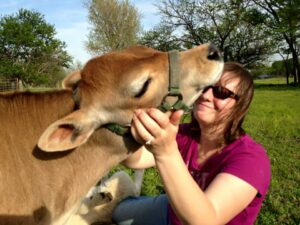
For many people, the initial investment for a trained cow is harder to manage financially. A young heifer calf, maybe even still on a bottle, is must less costly. The added benefit of a very young calf is she could be transported in a dog crate or enclosed truck bed.
It’s also important to consider the influence you can have on her health by knowing her diet during the first years when she’s growing the most. You can protect her from exposure to diseases from other animals and start her training from day one. It’s much easier to train a heifer to milk if she’s learned to trust you already. While that bond can be formed with an adult cow, there’s something to be said for the amount of time you have with a heifer before she enters the parlor.
Pros for Buying a Heifer Calf:
- Untrained
- Less expensive
- Less feed needed initially
- Potentially less disease exposure
- Enjoyment of raising her
- Easier to transport
- Easier to halter break
- Easier to earn their trust
- You’ll know the nutrition she’s had during her early years of development
Cons for Buying a Heifer Calf:
- Untrained
- Unknown mature height
- Long wait for milk
- Unknown udder
- Needs to be bred in a year
The biggest con to me, as a small milking farm, is training. I don’t have infrastructure like alleys or chutes to handle adult cattle. We use a simple head gate for milking, breeding, and doctoring. That means all of my cattle need to be halter broke and used to being handled. I’ve had successes, but some have been hard earned. Dam-raising a calf can be beautiful, but some calves are genetically predisposed to be more skittish. If you dam-raise, it’s imperative to work with your calf daily. You need to ensure that they’ll come when you want, allow you to work with them, and so you to give medical attention when needed. If a calf doesn’t warm up to you, it may be necessary to move them to a bottle to teach them good things come from people.
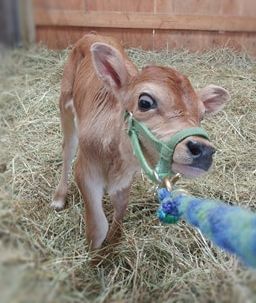
That also means, you’ll need to milk the dam twice a day, if you weren’t already. By the time a calf is 2 months old they should readily come to you for scratches and follow you around. If a cow hasn’t had human interaction, they might never make a good family milk cow. A new cow owner should not purchase an unhandled cow or calf and assume they can train them if they aren’t dedicated to the task and the patience and time it will take. Some will train easily, but there are many others that will remain difficult their whole lives.
Another thing to consider is the difficulty in finding your perfect cow in the current market, especially if your heart is set on the unicorn A2/A2 Purebred Mini Jersey. If you have a long list of traits you want, a calf might be the best way to go. Buying a heifer calf means you can’t see her udder until she calves. You’ll need to pay close attention to her dam’s udder and the sire’s dam’s udder. If you intend to hand milk, make sure the parents have long teats in their genetics. You also want a well-supported, high udder, held tight to the body that will stand up though a lifetime of producing calves and making milk. Learn all you can about her dam and sire. Take the time to do more research and ask questions.
Remember, whatever you decide, there’s no right or wrong answer to the question of starting with a heifer calf or a cow. It depends more on your individual situation, the particular cow or calf, and your willingness and ability to put in the time and effort needed for whatever you start with.
Good luck and may you never cry over spilled milk!
~Sabrina, PMJS Advisory Board
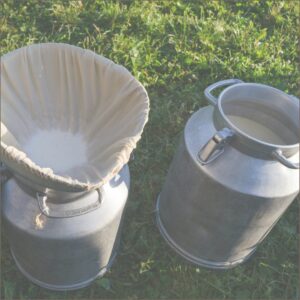
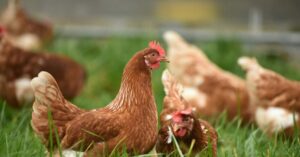

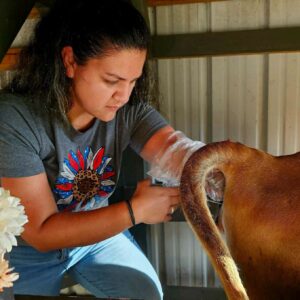
Thank you for this informative blog post. These are the things I tell folks interested in buying from us. It is nice to know others agree.
The more I learn of this registry, the more I am impressed!